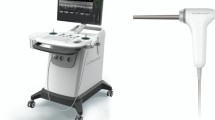Abstract
Optical coherence tomography (OCT) can be used as an adjunct to colposcopy in the identification of precancerous and cancerous cervical lesions. The purpose of this study was to investigate the effect of acetic acid on OCT imaging. OCT images were taken from unsuspicious and suspicious areas of fresh conization specimens immediately after resection and 3 and 10 min after application of 6 % acetic acid. A corresponding histology was obtained from all sites. The images taken 3 and 10 min after application of acetic acid were compared to the initial images with respect to changes in brightness, contrast, and scanning depth employing a standard nonparametric test of differences of proportions. Further, mean intensity backscattering curves were calculated from all OCT images in the histological groups CIN3, inflammation, or normal epithelium. Mean difference profiles within each of these groups were determined, reflecting the mean differences between the condition before application of acetic acid and the exposure times 3 and 10 min, respectively. According to the null hypothesis, the difference profiles do not differ from profiles fluctuating around zero in a stationary way, which implies that the profiles do not differ significantly from each other. The null hypothesis was tested employing the KPSS test. The visual analysis of 137 OCT images from 46 sites of 10 conization specimens revealed a statistically significant increase in brightness for all three groups and a statistically significant decrease in contrast for normal epithelium after 10 min. Further, an increase in scanning depth was noted for normal epithelium after 10 min and for CIN3 after 3 min. The analysis of mean intensity profiles showed an increased backscattering intensity after application of acetic acid. Acetic acid significantly affects the quality of OCT images. Overall brightness and scanning depth increase with the opposite effect regarding the image contrast. Whether the observed changes facilitate the distinction between dysplastic lesions in a clinical setting needs to be shown in further studies.




Similar content being viewed by others
References
Turchin IV, Sergeeva EA, Dolin LS, Kamensky VA, Shakhova NM, Richards-Kortum R (2005) Novel algorithm of processing optical coherence tomography images for differentiation of biological tissue pathologies. J Biomed Opt 10:064024
Zysk AM, Nguyen FT, Oldenburg AL, Marks DL, Boppart SA (2007) Optical coherence tomography: a review of clinical development from bench to bedside. J Biomed Opt 12:051403
Fujimoto JG, Pitris C, Boppart SA, Brezinski ME (2000) Optical coherence tomography: an emerging technology for biomedical imaging and optical biopsy. Neoplasia 2(1–2):9–25
Escobar PF, Rojas-Espaillat L, Tisci S, Enerson C, Brainard J, Smith J, Tresser NJ, Feldchtein FI, Rojas LB, Belinson JL (2006) Optical coherence tomography as a diagnostic aid to visual inspection and colposcopy for preinvasive and invasive cancer of the uterine cervix. Int J Gynecol Cancer 16:1815–1822
Gallwas JMD, Turk L, Friese K, Dannecker C (2010) Optical coherence tomography (OCT) as a non invasive imaging technique for preinvasive and invasive neoplasia of the uterine cervix. Ultrasound Obstet Gynecol 36(5):624–629
Gallwas J, Turk L, Stepp H, Mueller S, Ochsenkuehn R, Friese K, Dannecker C (2011) Optical coherence tomography for the diagnosis of cervical intraepithelial neoplasia. Lasers Surg Med 43(3):206–212
MacLean AB (2004) Acetowhite epithelium. Gynecol Oncol 95(3):691–694
Wu TT, Qu J, Cheung TH, Yim SF, Wong YF (2005) Study of dynamic process of acetic acid induced-whitening in epithelial tissues at cellular level. Opt Express 13(13):4963–4973
Pogue BW, Kaufman HB, Zelenchuk A, Harper W, Burke GC, Burke EE, Harper DM (2001) Analysis of acetic acid-induced whitening of high-grade squamous intraepithelial lesions. J Biomed Opt 6(4):397–403
Marina OC, Sanders CK, Mourant JR (2012) Effects of acetic acid on light scattering from cells. J Biomed Opt 17(8):085002-1
Zonios G (2012) Reflectance model for acetowhite epithelium. J Biomed Opt 17(8):087003-1
Fleiss JL, Levin B, Paik MC (2003) Statistical methods for rates and proportions, 3rd edn. John Wiley, New York
Kwiatkowski D, Phillips PCB, Schmidt P, Shin Y (1992) Testing the null hypothesis of stationarity against the alternative of a unit root. J Econ 54:159–178
URL http://www.R-project.org/. R core Team (2003) R: A language and environment for statistical computing. R Foundation for Statistical Computing Vienna, Austria
Kuznetsova IA, Gladkova ND, Gelikonov VM, Belinson JL, Shakhova NM, Feldchtein FI (2008) OCT in Gynecology. In: Drexler W, Fujimoto JG (eds) Optical coherence tomography, technology and applications. Springer, New York, pp 1211–1240
Gallwas J, Mortensen U, Gaschler R, Ochsenkuehn R, Stepp H, Friese K, Dannecker C (2012) Validation of an ex vivo human cervical tissue model for optical imaging studies. Lasers Surg Med 44(3):245–248
Hiller C, Bock U, Balser S, Haltner-Ukomadu E, Dahm M (2008) Establishment and validation of an ex vivo human cervical tissue model for local delivery studies. Eur J Pharm Biopharm 68(2):390–399
Acknowledgments
This study was supported by grants of the Friedrich-Baur-Stiftung and Mr. and Mrs. Armin Siegl.
Author information
Authors and Affiliations
Corresponding author
Rights and permissions
About this article
Cite this article
Gallwas, J., Stanchi, A., Dannecker, C. et al. Effect of acetic acid on optical coherence tomography (OCT) images of cervical epithelium. Lasers Med Sci 29, 1821–1828 (2014). https://doi.org/10.1007/s10103-014-1581-9
Received:
Accepted:
Published:
Issue Date:
DOI: https://doi.org/10.1007/s10103-014-1581-9




